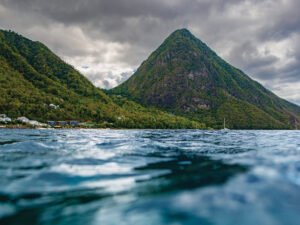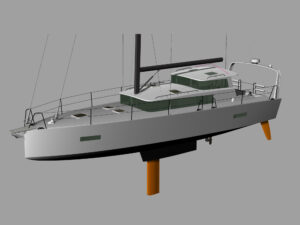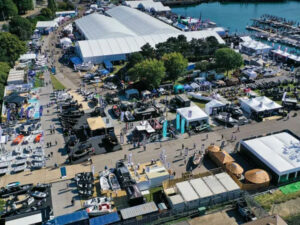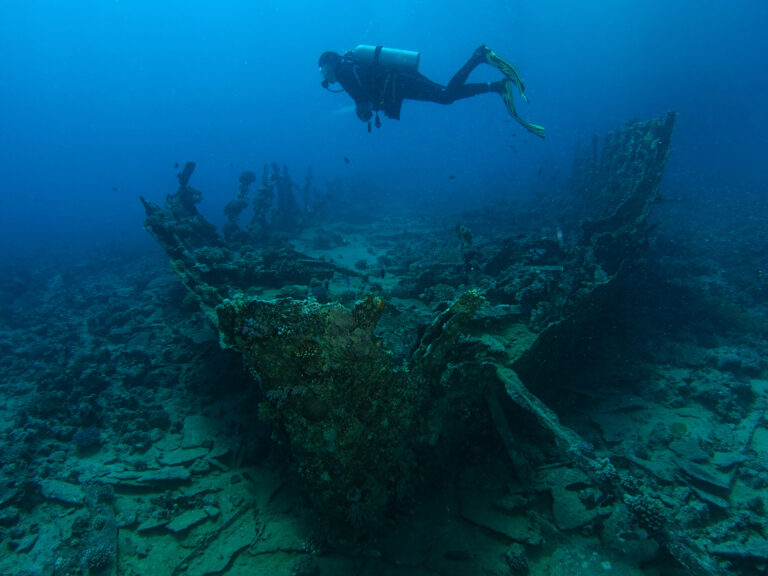
sanding wtih vacuum 368
In the not-so-good ol’ days, it was an annual rite of spring to head down to the boatyard with a palm sander and dust mask and come home covered head to toe with last year’s bottom paint. If you were lucky and it was windy, some of the toxic swirl that surrounded you for hours might blow away. On the other hand, if you were downwind and your neighbor was doing the same, well, you might end up with a double dose of copper-loaded joy. Yes, the yards of yore were rustic. Flowers, or what passed for them, would sprout up between broken cradles, upended engine blocks, old lead keels, and rusting paint and solvent cans. And boat owners could pretty much do what they wanted when it came to cleaning, maintenance, and repairs as long as the bill was paid.
For the most part, though, those days-and yards-are gone. Environmental regulations, liability concerns, and the very real desire on the part of many marina owners to protect the environment have all done their part to make marinas and boat-storage facilities in the United States much more ecofriendly. Dust and debris can no longer fall where it may. Cleaning materials need to be biodegradable. Customers want to see recycling bins, clean docks, landscaping, and litter-free parking lots. Strict state and federal guidelines prohibit both the discharge of petroleum products anywhere and, increasingly, the pumpout of sanitary wastes in coastal waters.
And pending are regulations from the Environmental Protection Agency that will set standards for washdown areas, so that runoff from powerwashing operations will have to be contained and recycled or treated.
Nationwide, 21 states have adopted voluntary Clean Marina programs that borrow heavily from best practices developed by the EPA and the National Oceanographic and Atmospheric Administration. And many of those same practices are being employed as yards and marinas clean up their acts to gain approval to expand or upgrade their operations.
Virtually every coastal state and most that border the Great Lakes offer Clean Marina certification plans, says Allison Castellan, a NOAA coastal management specialist. Evidence cited by NOAA indicates that marinas that participate benefit by attracting boaters willing to pay a little more to do business with those taking steps to protect the environment. Boaters, by their nature after all, appreciate clean water and the outdoors.
“I believe that if we don’t have clean water, we don’t have an industry,” says Skip Fry, at the Wilmington Marine Center in Wilmington, North Carolina. The center’s marina provides low-cost sanitary pumpouts and makes sure there are recycling opportunities at every dock ramp. Most important, he adds, “the attitude from the top down is that we’re really trying to clean things up here.”
Fry estimates some 300 boats a year get hauled out at the center. Hay bales and dams are used around the railway and Travelift, and debris from the boats is swept up at the end of the day and put in barrels. Powerwashing is done in a designated area that’s sloped so that runoff doesn’t find its way back to the water. Throughout the yard, there’s an effort to keep waste barrels near boats and to make sure tarps are on the ground when work is taking place.
Fry says that do-it-yourself projects are discouraged because of environmental and safety reasons. And even contractors coming into the yard must sign in daily; in doing so, they acknowledge that they’re aware of the center’s Clean Marina policies and other work regulations.
At the Marine Center, the area that’s most ripe for improvement, says Fry, is the washdown pad. Currently, it has a sand and gravel bottom that serves as a filter. To upgrade it, a cement slab large enough to hold a 70-foot boat could be poured so it incorporates a drain and sump. Water collected in the sump could then be recycled, treated, or sent off-site. Although the upgrade is in Fry’s budget, he’s holding off on pulling the trigger because at present, there are no standards in place.
The pending EPA guidelines for powerwashing have Jay Burns, the manager of Brewer Sakonnet Marina in Portsmouth, Rhode Island, taking a wait-and-see approach as well. Brewer owns a number of New England marinas, and until standards are handed down, the company is reluctant to commit to a technology that might be rendered obsolete by new state or EPA clean-water regulations.
On other green matters, though, Brewer is running a tight ship. Hay bales are used to contain solids in the marina’s washdown area, and there are containers stored indoors for used oils and other fluids.
Unlike the Wilmington Marine Center, Brewer lets do-it-yourselfers have at it, although anyone sanding a boat bottom in the yard is required to put down tarps and to use a vacuum-sanding system to collect dust. The yard even has a Fein system it rents out for $20 a day, plus sandpaper. Burns says he’d draw the line, though, if someone wanted to undertake an Awlgrip job or use other materials that are considered hazardous.
“People down here are really, really good,” he says of his customers. “They want to swim in the bay with their kids. They go out of their way to keep it clean.”
Three thousand miles or so to the west, do-it-yourselfers are also welcome at Driscoll Mission Bay, a boatyard and marina in San Diego and one of the few in the region that permits owners to do their own work. But because of stringent EPA and state regulations, liability, and insurance, yard manager Joe Driscoll says he keeps a close watch on them and admits that there may come a day when all work will have to be done by the yard. That’s already the case at the Driscoll family’s other marina, Driscoll Boat Works, on San Diego’s Shelter Island.
California has arguably the toughest environmental regulations in the country, but add the threat of lawsuits to the possibility of being hit with environmental fines, Driscoll says, and you’re quickly looking at a very real headache. When it comes to boat owners, most want to do the right thing, but a bad apple can spoil the pie. Driscoll recounted how one owner borrowed scaffolding from the yard, fell off it, then turned around and filed suit. Then there’s the fact that there are no regulations regarding what types of bottom paint can be sold in California. You can go to a chandlery and buy anything, but if you show up at the boatyard and start applying a paint that’s banned in that community’s paint district-yes, in California, they have paint districts-the yard, not the boat owner, faces legal action. That’s why Driscoll Mission Bay now requires all paint to be bought from its ship’s store.
In general, Driscoll’s restrictions aren’t that different from those reported elsewhere. All sanding dust must be contained, no dust and debris can fall off boats into the water, and in-the-water hull cleaning is discouraged. But on top of that, those working on hauled-out boats face a daily storage fee that Driscoll must charge to cover costs that include water-containment systems for washdown and rainwater runoff, sediment testing to monitor copper levels near the docks, and the many permits the yard and marina require to be in business. For anyone contemplating a major refit, it will likely be a lot cheaper to haul the boat to a storage facility inland.
There is one piece of good advice that Driscoll can offer a California boater: If you show up at a marina looking for a slip and can prove that you don’t have copper bottom paint on your boat, then, he says, “you’ll be bumped up to the top of the list.”
Liveaboard sailor Mark Pillsbury knows the challenges facing the DIYer in the yard.








